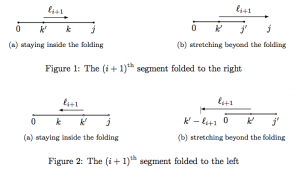September 24, 2011
1 2 3 4 5 6 7 8 9 10 11 12 13 14 15 16 17 18 19 20 21 22 23 24 25 26 27 28 29 30 31 32 33 34 35 36 37 38 39 40 41 42 43 44 45 46 47 48 49 50 51 52 53 54 55 56 57 58 59 60 61 62 63 64 65 66 67 68 69 70 71 72 73 74 75 76 77 78 79 80 81 82 83 84 85 86 87 88 89 90 91 92 93 94 95 96 97 98 99 100 101 102 103 104 105 106 107 108 109 110 111 112 113 114 115 116 117 118 119 120 121 122 123 124 125 126 127 128 129 130 131 132 133 134 135 136 137 138 139 140 141 142 143 144 145 146 | \documentclass{article}% For fancy drawing\usepackage{tikz, subfigure}\usepackage[papersize={140mm, 100mm}, text={130mm, 90mm}]{geometry}% order: \order[st]{1}, \order{k}\newcommand{\order}[2][th]{\ensuremath{{#2}^{\mathrm{#1}}}}\begin{document}\pagestyle{empty}\begin {figure}[h] \centering \subfigure[staying inside the folding]{ \begin{tikzpicture} [ line/.style = {draw, thick}, arrow/.style = {draw, semithick, -latex}, dot/.style = {draw, fill=black}, ] \coordinate (O) at (3cm, 0cm); \coordinate (J) at (1cm, 0cm); \coordinate (L) at (2cm, 0cm); \coordinate (K) at (4cm, 0cm); \coordinate (A) at (0cm, 0cm); \coordinate (B) at (5cm, 0cm); \node at (A) {}; \node at (B) {}; \path [arrow] ([yshift=2mm]L) -- node [above] {$\ell_{i+1}$} ([yshift=2mm]O); \path [line] (J) -- (K); \fill [dot] (J) circle (.3mm); \fill [dot] (L) circle (.3mm); \fill [dot] (K) circle (.3mm); \node [below] at (L) {$k'$}; \node [below] at (K) {$j$}; \node [below] at (J) {$0$}; \node [below] at (O) {$k$}; \end{tikzpicture} } \qquad\qquad \subfigure[stretching beyond the folding]{ \begin{tikzpicture} [ line/.style = {draw, thick}, arrow/.style = {draw, semithick, -latex}, dot/.style = {draw, fill=black}, ] \coordinate (O) at (3cm, 0cm); \coordinate (J) at (0cm, 0cm); \coordinate (L) at (1cm, 0cm); \coordinate (K) at (2cm, 0cm); \coordinate (A) at (-1cm, 0cm); \coordinate (B) at (4cm, 0cm); \node at (A) {}; \node at (B) {}; \path [arrow] ([yshift=2mm]L) -- node [above] {$\ell_{i+1}$} ([yshift=2mm]O); \path [line] (J) -- (K); \fill [dot] (J) circle (.3mm); \fill [dot] (L) circle (.3mm); \fill [dot] (K) circle (.3mm); \node [below] at (L) {$k'$}; \node [below] at (K) {$j'$}; \node [below] at (O) {$j$}; \node [below] at (J) {0}; \end{tikzpicture} } \caption{The $\order{(i+1)}$ segment folded to the right}\end{figure}\begin {figure}[h] \centering \subfigure[staying inside the folding]{ \begin{tikzpicture} [ line/.style = {draw, thick}, arrow/.style = {draw, semithick, -latex}, dot/.style = {draw, fill=gray!50}, ] \coordinate (O) at (2cm, 0cm); \coordinate (J) at (1cm, 0cm); \coordinate (L) at (3cm, 0cm); \coordinate (K) at (4cm, 0cm); \coordinate (A) at (0cm, 0cm); \coordinate (B) at (5cm, 0cm); \node at (A) {}; \node at (B) {}; \path [arrow] ([yshift=2mm]L) -- node [above] {$\ell_{i+1}$} ([yshift=2mm]O); \path [line] (J) -- (K); \fill [dot] (J) circle (.3mm); \fill [dot] (L) circle (.3mm); \fill [dot] (K) circle (.3mm); \node [below] at (L) {$k'$}; \node [below] at (K) {$j$}; \node [below] at (J) {$0$}; \node [below] at (O) {$k$}; \end{tikzpicture} } \qquad\qquad \subfigure[stretching beyond the folding]{ \begin{tikzpicture} [ border/.style = {draw=gray!90, thick}, line/.style = {draw, thick}, arrow/.style = {draw, semithick, -latex}, dot/.style = {draw, fill=gray!50}, ] \coordinate (O) at (0cm, 0cm); \coordinate (J) at (1cm, 0cm); \coordinate (L) at (2cm, 0cm); \coordinate (K) at (3cm, 0cm); \path [arrow] ([yshift=2mm]L) -- node [above] {$\ell_{i+1}$} ([yshift=2mm]O); \path [line] (J) -- (K); \fill [dot] (J) circle (.3mm); \fill [dot] (L) circle (.3mm); \fill [dot] (K) circle (.3mm); \node [below] at (J) {$0$}; \node [below] at (L) {$k'$}; \node [below] at (K) {$j'$}; \node [below] at (O) {$k'-\ell_{i+1}$}; \path [border] (O) -- ([yshift=3mm]O); \end{tikzpicture} } \caption{The $\order{(i+1)}$ segment folded to the left}\end{figure}\end{document} |
Comments Off on carpenter’s ruler

no comment until now